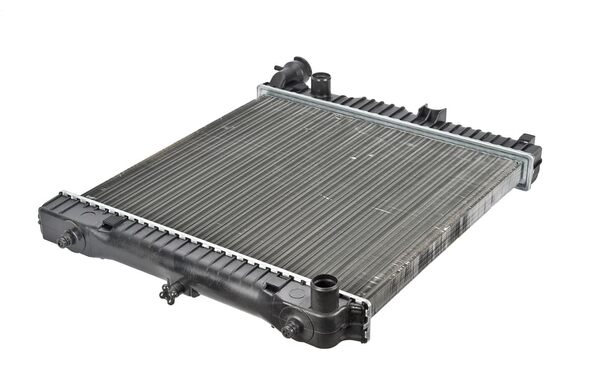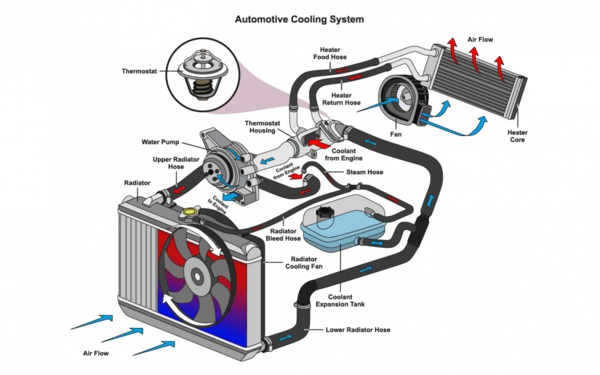5 Signs You Need a Radiator Flush
What is a Car Radiator and Radiator Flush?
A car radiator helps keep the engine from getting too hot by cooling it down. It’s like a container with many small pathways inside. Coolant, a special liquid, flows through these pathways, taking away the engine’s heat. Then, air passing through the radiator cools the coolant before it goes back into the engine. So, the radiator helps your car stay at the right temperature while you drive.
A radiator flush is giving your car’s cooling system a deep clean. It involves using a special cleaning solution to remove dirt, rust, and other gunk that can build up inside the radiator and engine block over time. By flushing out these contaminants, the cooling system can work better, which helps prevent your engine from overheating. It’s an important car maintenance task that should be done periodically to keep your car running smoothly. Typically, a radiator flush is recommended if the coolant isn’t clear or if there are signs of corrosion in the cooling system. It’s also a good idea to flush the radiator whenever you drain and refill the coolant to keep everything in good condition.
5 Signs Your car needs a Radiator Flush
You car is overheating
If your car’s temperature gauge is consistently higher than normal, it could be a sign that your radiator needs attention. Overheating is often caused by a buildup of dirt and debris in the radiator, preventing proper cooling. This can lead to serious engine problems if not taken care of right away. Keeping an eye on your temperature gauge and noticing any unusual fluctuations is major. If you think you might need a radiator flush, it’s best to have it checked by a mechanic to prevent further damage to your car. Don’t ignore the signs of overheating, as they could indicate a bigger issue with your car’s cooling system. If not fixed, it could lead to engine failure and that’s more costly.
Rusty Coolant
If you see rusty or discoloured coolant in your car’s reservoir, it’s a sign that there may be contaminants in your cooling system. This buildup can happen over time and could lead to problems if not checked on. Getting a radiator flush might be necessary to remove the debris and keep your cooling system working well. Rusty or discoloured coolant isn’t just unsightly; it can indicate potential issues that need attention. It’s important to keep an eye on the condition of your coolant and address any changes right away to prevent damage to your car’s engine. Prevention is a cure!
Low Coolant Levels
If you’re frequently adding coolant to your car, it might mean there’s a leak or a blockage in your cooling system. Low coolant levels can lead to overheating and engine damage if left unchecked. A radiator flush could help clear any blockages and make sure your cooling system is working properly. Keeping an eye on your coolant levels is important for maintaining your car’s health. If you’re constantly refilling the coolant, it’s a sign that something might be wrong. Don’t ignore this warning sign—get your car checked by a professional to diagnose and fix the issue. Preventative maintenance like a radiator flush can save you from more significant problems down the road.
Car doesn’t Perform as well
If your car feels slow or doesn’t work as well as before, it might be because of a clogged radiator. When junk builds up in the radiator, it slows down the flow of coolant through the engine. This can make your car run poorly and use more fuel. A radiator flush can help clean out the junk and get things back to normal. If you notice your car having trouble speeding up or staying at a steady speed, it’s a good idea to have the car radiator checked. Keeping your cooling system clean and working right is important for your car to run well and last longer.
Strange Smell or Steam
If you catch a strange sweet smell or see steam rising from under your car’s hood, it might mean trouble. This could happen if there’s a leak in the coolant system or if the car radiator is blocked and causing the coolant to boil. A radiator flush can help clear out any blockages and fix the problem. Ignoring these signs could lead to bigger issues with your car’s engine, so it’s best to get it checked out as soon as you notice anything unusual. Keeping an eye (and nose!) out for these signs can help you catch radiator problems early and avoid major repairs later on.
How often should I get a radiator flush for my car?
You should get a radiator flush for your car as recommended in the owner’s manual or by your mechanic. Typically, it’s recommended every 50,000 to 80,000 kilometres, or every couple of years, but it can vary depending on your vehicle and driving conditions. Regular maintenance helps keep your cooling system in good shape and prevents overheating issues.
FAQ
Can I flush my radiator myself?
Yes, you can flush your radiator yourself. Just drain the old coolant, flush it with water or a special solution, refill with new coolant, and remove any air bubbles. If you’re unsure, ask for help or have a mechanic do it.
Can a radiator flush fix overheating?
Yes, a radiator flush can sometimes fix overheating issues. It helps remove built-up debris and other dirt from the radiator, allowing coolant to flow more freely and cool the engine better. However, if the overheating is caused by more serious issues like a faulty thermostat or water pump, a radiator flush may not fully resolve the problem for you. It’s best to have a mechanic take a look and give you a proper solution.
What is a difference between coolant exchange and a flush?
A coolant exchange is changing the liquid in your car’s radiator. It’s a straightforward process of draining out the old coolant and pouring in new coolant. It’s kind of like changing the oil in your car.
A flush, on the other hand, is giving your cooling system a deep clean. It involves using a special solution to flush out any gunk or buildup that might be clogging up the system. This helps make sure that your radiator and other parts of the cooling system are clean and working well. So, while a coolant exchange is just swapping out the old coolant for new, a flush is like giving your cooling system a new life.
What happens if you don’t flush radiator?
If you skip flushing your radiator, dirt and debris can accumulate inside it over time. This buildup can make your engine overheat, leading to potential damage. Additionally, it might cause leaks and other issues in your car’s cooling system. Regular radiator flush helps prevent these problems, keeping your car working well and avoiding major repairs later on.
Is better to flush or replace a radiator?
It’s usually better to flush your radiator first before considering replacement. Flushing removes built-up debris and contaminants, improving the radiator’s performance and prolonging its lifespan. However, if the radiator is severely damaged or corroded, replacement may be necessary to assure proper cooling system function.
Visit us in Tauranga for a radiator flush.


